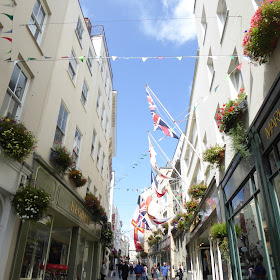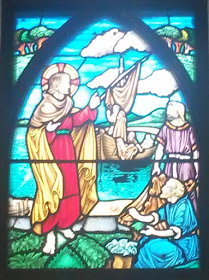201 Squadron Royal Air Force has been affiliated to Guernsey since May 1939. The Squadron Museum is located in Cornet Castle, St Peter Port, and Squadron Standards are laid up in the Parish Church.
The origins of 201 Squadron lie in no 1 Squadron Royal Naval Air Service (RNAS) which was formed at Fort Grange on 14th October 1914.
 |
| No 1 Squadron RNAS 1914 |
On the outbreak of war, the Squadron was engaged on coastal patrols, before deploying to France during 1915. The squadrons role included reconnaissance, photography, bombing and artillery spotting flights, mainly around the Ostend/Zeebruge area.
On the night of 6th / 7th June 1915, Flight Sub-Lieutenant RAJ Warenford sighted Zeppelin LZ37 over Bruges. Positioning himself 150 feet above the Zeppelin, he dropped six bombs on top of the airship. The sixth bomb hit the Zeppelin and it crashed to the ground in flames. The blast from the explosion turned his aircraft upside down and damaged it's engine. He was forced to land in enemy territory, however he was able to make repairs, take off and return to base.
For his actions Flight Sub-Lieutenant RAJ Warenford was awarded the Victoria Cross, the first ever awarded for any type of air combat. Tragically he was killed just over a week later in an air accident.
 |
Flight Sub-Lieutenant RAJ Warenford
VC Action - Destruction of Zeppelin LZ37 |
 |
| Flight Sub-Lieutenant RAJ Warenford VC |
 |
F/Sub-Lt RAJ Warenford VC
201 Squadron Museum Castle Cornet
Guernsey |
The Squadron achieved another first on 26th August 1915 when Squadron Commander Bigsworth made the first ever confirmed airborne “kill” on a submarine, surprissin the U-14 off the Belgian coast near Ostend.
On 1st April 1918 the Royal Air Force was formed from the Royal Flying Corps and the Royal Naval Air Service. The squadron was designated 201 Squadron Royal Air Force.
The Squadron would have another recipient of the Victoria Cross when Major WG Barker was awarded the VC for his actions on 27th October 1918. Despite being severely wounded he shot down three enemy aircraft.
 |
Major WG Barker VC Action
27th October 1918 |
Major 'Billy' Barker was already a well decorated air ace adding the VC to a Distinguished Service Order and Bar, and Military Cross with two Bars. He held the highest destroyed record of any pilot in WW1 and would return to Canada after the war as the highest decorated soldier.
 |
| Major WG Barker VC DSO+Bar MC+2Bars |
The Squadron was disbanded at RAF Eastleigh on 31st December 1919. It had destroyed at least 2 submarines, 280 enemy aircraft, its personnel included 18 air aces (five or more confirmed kills) and the awarding of 2 Victoria Crosses.
 |
World War One
Aircraft used by the Squadron |
The Squadron was reformed at RAF Calshot 1st January 1929 as a Flying Boat Squadron. It was equipped with Southampton Flying Boats untill 1936, then Saro Flying Boats till the outbreak of World War Two. The affiliation of the Squadron to the Bailwick of Guernsey was announced in May 1939.
 |
201 Squadron RAF
Southampton Flying Boats |
 |
201 Squadron RAF
Saro Flying Boat visits Guernsey |
 |
201 Squadron RAF
Flying Boat Pilot |
When the Second World war broke out in September 1939, the Squadron was based in the north of Scotland. It conducted reconnaissance patrols in the North Sea and Norwegian Coastal Waters. In April 1940, 201 converted to Short Sunderland Flying Boats moving to Northern Ireland in October 1940.
Their role was to conduct anti-submarine patrols in during the Battle of the Atlantic.
 |
| Battle of the Atlantic - Coastal Command dispositions |
 |
Battle of the Atlantic
Air Cover on Convoy Routes |
 |
| Battle of the Atlantic |
The Squadron achieved their first confirmed U-Boat kill on 20th March 1943 when one of their aircraft surprised U-384 on the surface, sinking it in the subsequent action. A second kill was made two months later with the sinking of U-440.
 |
Battle of the Atlantic
201 Squadron aircraft T surprises U-384 |
 |
Battle of the Atlantic
201 Squadron sinking of U-384 |
The Squadron moved to Pembroke Dock, Wales, in April 1944. They were tasked with patrolling the western entrance to the English Channel to protect the D-Day Landings and subsequent development of the Normandy Bridgehead. During the period 7th June to 18th August the Squadron sank 3 U-Boats in the Bay of Biscay.
201 Squadron U-Boat kills WW2
| U-boat | Date | Location |
| U-384 | 20 March 1943 | North Atlantic |
| U-440 | 31 May 1943 | NW of Cape Ortegal |
| U-955 | 7 June 1944 | Bay of Biscay |
| U-1222 | 11 July 1944 | Bay of Biscay |
| U-107 | 18 August 1944 | Bay of Biscay |
During the Second World War of the Squadron's crews had flown over 20,000 operational hours. They were awarded, one Distinguished Service Order, 12 Distinguished Flying Crosses (and 2 Bars) and 11 Distinguished Flying Medals.
In 1948, the Soviet Union blockaded the land corridors from West Germany through East Germany to Berlin. To break the Berlin Blockade the Western Powers brought in supplies by air, an operation which would be designated the Berlin Airlift, The operation lasted from 26 June 1948 – 30 September 1949.
 |
Berlin Airlift 1948
Air Corridors |
During the operation 201 Squadrons Short Sunderland's were found to be particularly suitable for carrying salt being the only aircraft proofed against corrosion.
 |
Berlin Airlift 1948 201 Squadron Short Sunderland
moored on the Havel Berlin unloading salt |
The Squadron would continue with Short Sunderland's until it disbanded in February 1957.
 |
201 Squadron RAF
Tower Bridge London 1956 |
The Squadron reformed in October 1958 equipping with Shackletons. The Squadron was involved in reconnaissance operations in the Caribbean, the Malaya Emergency, and the Arabian Gulf.
 |
201 Squadron RAF
Avro Shackleton |
201 Squadron became the first unit to equip with Nimrods in November 1970. Based at RAF Kinross, the Cold War saw them tasked with surveillance of the Soviet Fleet in the North Atlantic.
 |
201 Squadron RAF
Nimrod |
 |
201 Squadron RAF Museum
|
 |
201 Squadron RAF
Nimrod Sonar |
The Squadron would once again be deployed on active service when their Nimrods deployed to Ascension Island during the South Atlantic conflict to retake the Falklands. Their role was to conduct surveillance missions off the Argentinian Coast, an operation which involved refuelling 3 times form Victor Tankers.
Links to Guernsey were re-in forced with the laying up of the Squadron Standard in the Parish Church St Peter Port in March 1985
 |
201 Squadron RAF
Laying up of Squadron Standard
March 1985 |
Operational service continued with the Gulf War in 1990, flying surveillance and targeting operations against the Iraqi Navy. During the Balkans conflict they supported NATO operations patrolling the Adriatic. Returning to the Middle East, 201 Squadron were involved with the Invasion of Iraq and Afghanistan.
 |
201 Squadron RAF
St Peter Port Guernsey |
Source:wikipedia
The Squadron Standard hangs in the Parish Church in St Peter Port and records the Squadrons Battle Honours.
Battle Honours
Western Front 1915–1918*: Arras*; Ypres 1917*; Somme 1918* Amiens; Hindenburg Line
Channel and North Sea 1939–1945;Norway 1940*; Atlantic 1941 -1945*;Bismarck*; Biscay 1941-1945;Normandy 1944*
South Atlantic 1982; Gulf 1991; Iraq 2003
Honours marked with an asterisk(*) are those emblazoned on the Squadron Standard
 |
| St Peter Port Parish Church Guernsey |
 |
201 Squadron RAF Standards
St Peter Port Parish Church Guernsey |
 |
201 Squadron RAF
St Peter Port Parish Church Guernsey |





































































